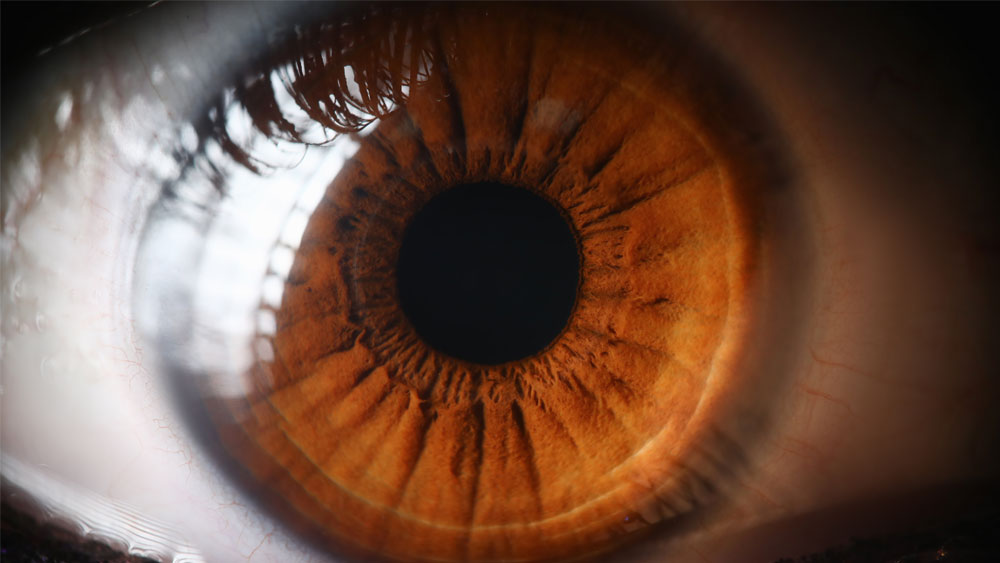There’s certainly nothing uncomplicated about the eye, simple1 or otherwise.
Some of us remember learning about basic vision from high school biology. What we look at strikes the back of the eye, which is composed of a thin layer (half the width of a dime) of tissue called the retina. This photoactive tissue is packed with neurons. These cells
receive and transmit optical data to the brain. Each neuron views the world through a small “window,” or receptive field. Researchers at the Salk Institute for Biological Studies have discovered that these irregularly-shaped receptive fields actually fit tightly together like puzzle pieces. This avoids the occurrence of blind spots, which would result if there were gaps between the fields. It also prevents blurred vision, which would occur if the fields had too much overlap. Thus, “the nervous system operates with higher precision than previously appreciated and…apparent irregularities in individual cells may actually be coordinated and finely tuned to make the most of the world around us.”2
An addition to this discovery is recent fascinating research into neuroscientific models of our vision. People and animals take in the visual world like a camera, but our eyes and brain are able to view “the positions of different objects similarly. An animal's [and human] surrounding environment, however, constantly changes, and these changes could also influence the processing of visual information.”3
Using mouse retinas, scientists at the Institute of Science and Technology in Austria and LMU in Germany put together evidence that supports their theory that the way neurons are organized is affected by wide view (panoramic) visual statistics.
“We set out to test this idea by taking advantage of the most prominent visual changes observed systematically in nature: the gradient of light intensity and contrast levels from the ground to the sky to ask if the mouse visual system evolved to consider these constraints." To examine the organization of sensory space that activate each neuron in the mouse retina (receptive fields) in relation to the scenes that mice are observing, [Maximillian] Jösch and his colleagues developed a new optical imaging technique. This technique allows them to measure and track the activity of thousands of neurons in a single retina simultaneously.3
Creationists maintain with the incredible details involved in vertebrate vision, the mouse’s visual system did not slowly evolve4 through chance and time “to consider these constraints," but were originally created with this amazing ability. Indeed, Jösch stated that, "A key feature of every living organism is adapting to its environment to survive."3 Creationists agree. God created plants and animals to move in and fill niches in the environment via continuous environmental tracking.
Jösch and his colleagues found that the computations performed by neurons in the mice retina changed depending on the panoramic visual statistics of what that part of the retina usually sees during daylight. This supports their initial hypothesis that the visual system is not inherently homogenous and is in fact adapted to the external environment. "To our surprise, we found that retinal neurons are more likely to inform the rest of the brain when a stimuli change is unexpected," Jösch said. "Importantly, the unexpected depends on where the neuron looks, either the sky or the ground. Thus, retina circuits systematically adapted their properties from the lower to the higher visual field to represent the world more efficiently."3
These findings aid in further comprehension of vertebrate visual systems and thus how the Creator, the Lord Jesus, designed the incredible ability of sight in the beginning.
References
- Sherwin, F. 2017. Do 'Simple' Eyes Reflect Evolution? Acts & Facts. 46 (9): 20.
- Thomas, B. Retinal Coordination: Picture Perfect Presentation of Design. Creation Science Update. Posted on ICR.org April 15, 2009, accessed April 11, 2023.
- Fadelli, I. The functional organization of cells in the retina is shaped by natural panoramic environments. Medical Xpress. Posted on medicalxpress.com April 7, 2023, accessed April 11, 2023.
- Thomas, B. Do Eyes Carry ‘Scars of Evolution’? Creation Science Update. Posted on ICR.org August 24, 2011, accessed April 11, 2023.
* Dr. Sherwin is science news writer at the Institute for Creation Research. He earned an M.A. in zoology from the University of Northern Colorado and received an Honorary Doctorate of Science from Pensacola Christian College.














